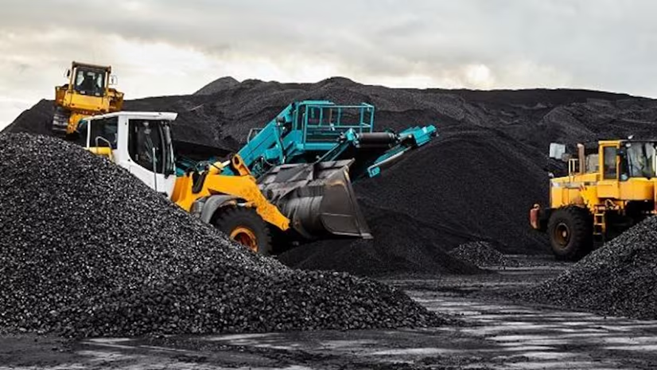- Courses
- GS Full Course 1 Year
- GS Full Course 2 Year
- GS Full Course 3 Year
- GS Full Course Till Selection
- Answer Alpha: Mains 2025 Mentorship
- MEP (Mains Enrichment Programme) Data, Facts
- Essay Target – 150+ Marks
- Online Program
- GS Recorded Course
- NCERT- First Ladder
- Polity
- Geography
- Economy
- Ancient, Medieval and Art & Culture AMAC
- Modern India, Post Independence & World History
- Environment
- Governance
- Science & Technology
- International Relations and Internal Security
- Disaster Management
- Ethics
- Current Affairs
- Indian Society and Social Issue
- CSAT
- 5 LAYERED ARJUNA Mentorship
- Public Administration Optional
- ABOUT US
- OUR TOPPERS
- TEST SERIES
- FREE STUDY MATERIAL
- VIDEOS
- CONTACT US
Coal Quality and Grades in India
Coal Quality and Grades in India
04-06-2024

Coal, a fossil fuel primarily composed of carbon, ash, moisture, and other impurities, plays a significant role in energy production and steel manufacturing.
- Its quality is determined by factors such as calorific value, carbon content, and ash content.
Coal Quality and Grading:
- Understanding Coal Quality:
- The Gross Calorific Value (GCV) of coal determines its quality, representing the amount of heat or energy generated upon combustion.
- Higher carbon content typically indicates better coal quality.
- Types of Coal and Grading:
- Coal is classified into categories based on its properties:
- Non-coking coal is graded based on Gross Heat content.
- Coking coal is graded based on ash percentage.
- Semi-coking coal and weakly coking coal are graded based on ash and moisture percentages.
- Coal is classified into categories based on its properties:
Types of Coal: Coal is classified into several categories. The 4 primary types of coal are:
- Anthracite: This is the highest quality coal and is known as hard coal. It contains a high proportion of fixed carbon and a low proportion of volatile matter.
- Bituminous: Bituminous coal is a medium-quality coal. It typically has a high heat (Btu) value and is used for electricity generation and steel production.
- Subbituminous: This coal has low to moderate heating values and is primarily used for electricity generation.
- Lignite: This is the lowest grade of coal, with the lowest carbon concentration. It has a low heating value and a high moisture content and is primarily used for electricity generation.
Coal Grades in India:
- The higher the available carbon in a unit of coal, the better its quality or 'grade.'
- There are 17 grades of coal in India, ranging from grade 1 (highest quality) to the lowest grade.
- Grade 1 coal yields over 7,000 kcal/kg, while the lowest grades yield 2,200-2,500 kcal/kg.
Coal Application Context:
- The suitability of coal depends on its intended application, such as thermal power plants or steel production, each requiring different coal types.
- Non-coking coal with higher ash content is commonly used in thermal power plants, generating sufficient heat for boilers and turbines.
- Coking coal with minimal ash content is essential for steel production.
Characteristics of Indian Coal:
- Low Calorific Value:
- Indian coal is historically evaluated as having a high ash content and a low calorific value compared to imported coal.
- The average GCV of domestic thermal coal ranges from 3,500-4,000 kcal/kg, significantly lower than imported thermal coals with a GCV of +6,000 kcal/kg.
- High Ash Content:
- The average ash content of Indian coals is more than 40%, far higher than imported coals with less than 10% ash content.
- Burning high-ash coal results in increased particulate matter, nitrogen, and sulfur dioxide emissions.
- Government Policies:
- Since 1954, the Indian government has controlled coal prices to discourage the use of high-grade coking coal for power generation.
- To balance coal production, power needs, and pollution, the government recommends blending imported coal with lower ash and moisture content with Indian coal.
Clean Coal: Clean coal refers to technologies and practices designed to mitigate the environmental impact of coal energy production, aiming to make coal a cleaner energy source.
Production Methods:
- Key Aspects:
- Carbon Capture and Storage (CCS): Involves capturing carbon dioxide emissions from coal-fired power plants and storing them underground to prevent their release into the atmosphere.
- Coal Washing: Removing impurities from coal before combustion, reducing emissions of ash, sulfur, and other pollutants.
- Flue Gas Desulfurization (FGD): Also known as scrubbers, this technology removes sulfur dioxide from the exhaust flue gases of coal-fired power plants.
- Gasification: Converting coal into synthetic gas (syngas), which can be burned more cleanly than coal.
- Advanced Combustion Techniques: Improving coal combustion efficiency to reduce emissions and increase energy output.
Coal Washing Disadvantages:
- Costly Process: Coal washing techniques, such as using blowers to remove ash and moisture, can increase power production expenses.
Coal Gasification:
- Alternative Method: Coal gasification involves converting coal into gas, offering an alternative to traditional coal combustion.
- Integrated Gasification Combined Cycle (IGCC) Systems: These systems utilize steam and pressurized air or oxygen to create syngas (carbon monoxide, hydrogen, CO2, and water vapor).
- Syngas Utilization: Syngas is cleaned and burned in gas turbines to produce electricity.
- Increased Efficiency: IGCC systems enhance coal efficiency by generating both steam and syngas.
Future of Coal in India:
- Production:
- Growth: India produced 997 million tonnes of coal in 2023-24, exhibiting an 11% growth compared to the previous year.
- Major Contributor: State-owned Coal India Ltd and its subsidiaries account for a significant portion of this production.
- Coal's Role in India's Energy Economy:
- Mainstay: Despite commitments to transition away from fossil fuels, coal remains the backbone of India's energy economy.
- Shift Towards Renewables:
- Record Generation: In Q1 of 2023, renewable energy accounted for 71.5% of the record 13.6 GW power generation capacity added by India.
- Coal's Share Declines: For the first time since the 1960s, coal's share (including lignite) of total power capacity dropped below 50%.



